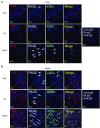A Pilot Study Linking Endothelial Injury in Lungs and Kidneys in Chronic Obstructive Pulmonary Disease
- PMID: 28085500
- PMCID: PMC5470750
- DOI: 10.1164/rccm.201609-1765OC
A Pilot Study Linking Endothelial Injury in Lungs and Kidneys in Chronic Obstructive Pulmonary Disease
Abstract
Rationale: Patients with chronic obstructive pulmonary disease (COPD) frequently have albuminuria (indicative of renal endothelial cell injury) associated with hypoxemia.
Objectives: To determine whether (1) cigarette smoke (CS)-induced pulmonary and renal endothelial cell injury explains the association between albuminuria and COPD, (2) CS-induced albuminuria is linked to increases in the oxidative stress-advanced glycation end products (AGEs) receptor for AGEs (RAGE) pathway, and (3) enalapril (which has antioxidant properties) limits the progression of pulmonary and renal injury by reducing activation of the AGEs-RAGE pathway in endothelial cells in both organs.
Methods: In 26 patients with COPD, 24 ever-smokers without COPD, 32 nonsmokers who underwent a renal biopsy or nephrectomy, and in CS-exposed mice, we assessed pathologic and ultrastructural renal lesions, and measured urinary albumin/creatinine ratios, tissue oxidative stress levels, and AGEs and RAGE levels in pulmonary and renal endothelial cells. The efficacy of enalapril on pulmonary and renal lesions was assessed in CS-exposed mice.
Measurements and main results: Patients with COPD and/or CS-exposed mice had chronic renal injury, increased urinary albumin/creatinine ratios, and increased tissue oxidative stress and AGEs-RAGE levels in pulmonary and renal endothelial cells. Treating mice with enalapril attenuated CS-induced increases in urinary albumin/creatinine ratios, tissue oxidative stress levels, endothelial cell AGEs and RAGE levels, pulmonary and renal cell apoptosis, and the progression of chronic renal and pulmonary lesions.
Conclusions: Patients with COPD and/or CS-exposed mice have pulmonary and renal endothelial cell injury linked to increased endothelial cell AGEs and RAGE levels. Albuminuria could identify patients with COPD in whom angiotensin-converting enzyme inhibitor therapy improves renal and lung function by reducing endothelial injury.
Keywords: COPD; cigarette smoke; comorbidities; endothelium; kidney.
Figures






Comment in
-
EnRAGEed Kidneys in Chronic Obstructive Pulmonary Disease?Am J Respir Crit Care Med. 2017 Jun 1;195(11):1411-1413. doi: 10.1164/rccm.201701-0173ED. Am J Respir Crit Care Med. 2017. PMID: 28569576 Free PMC article. No abstract available.
-
Reply to Voelkel: Cigarette Smoke Is an Endothelial Cell Toxin.Am J Respir Crit Care Med. 2018 Jan 15;197(2):274-275. doi: 10.1164/rccm.201707-1381LE. Am J Respir Crit Care Med. 2018. PMID: 28726486 Free PMC article. No abstract available.
-
Cigarette Smoke Is an Endothelial Cell Toxin.Am J Respir Crit Care Med. 2018 Jan 15;197(2):274. doi: 10.1164/rccm.201706-1123LE. Am J Respir Crit Care Med. 2018. PMID: 28726501 No abstract available.
Similar articles
-
A Disintegrin and Metalloproteinase Domain-8: A Novel Protective Proteinase in Chronic Obstructive Pulmonary Disease.Am J Respir Crit Care Med. 2018 Nov 15;198(10):1254-1267. doi: 10.1164/rccm.201707-1331OC. Am J Respir Crit Care Med. 2018. PMID: 29750543 Free PMC article.
-
COPD as an endothelial disorder: endothelial injury linking lesions in the lungs and other organs? (2017 Grover Conference Series).Pulm Circ. 2018 Jan-Mar;8(1):2045894018758528. doi: 10.1177/2045894018758528. Pulm Circ. 2018. PMID: 29468936 Free PMC article.
-
Heightened endoplasmic reticulum stress in the lungs of patients with chronic obstructive pulmonary disease: the role of Nrf2-regulated proteasomal activity.Am J Respir Crit Care Med. 2009 Dec 15;180(12):1196-207. doi: 10.1164/rccm.200903-0324OC. Epub 2009 Oct 1. Am J Respir Crit Care Med. 2009. Retraction in: Am J Respir Crit Care Med. 2016 Feb 1;193(3):344. doi: 10.1164/rccm.1933retraction. PMID: 19797762 Free PMC article. Retracted.
-
Role of apoptosis in the pathogenesis of COPD and pulmonary emphysema.Respir Res. 2006 Mar 30;7(1):53. doi: 10.1186/1465-9921-7-53. Respir Res. 2006. PMID: 16571143 Free PMC article. Review.
-
Dysfunction of pulmonary vascular endothelium in chronic obstructive pulmonary disease: basic considerations for future drug development.Curr Drug Metab. 2008 Sep;9(7):661-7. doi: 10.2174/138920008785821684. Curr Drug Metab. 2008. PMID: 18781916 Review.
Cited by
-
Association between pulmonary function and rapid kidney function decline: a longitudinal cohort study from CHARLS.BMJ Open Respir Res. 2024 Feb 23;11(1):e002107. doi: 10.1136/bmjresp-2023-002107. BMJ Open Respir Res. 2024. PMID: 38395458 Free PMC article.
-
Reply to Voelkel: Cigarette Smoke Is an Endothelial Cell Toxin.Am J Respir Crit Care Med. 2018 Jan 15;197(2):274-275. doi: 10.1164/rccm.201707-1381LE. Am J Respir Crit Care Med. 2018. PMID: 28726486 Free PMC article. No abstract available.
-
The importance of translational science within the respiratory field.Breathe (Sheff). 2024 Mar;20(1):230183. doi: 10.1183/20734735.0183-2023. Epub 2024 May 14. Breathe (Sheff). 2024. PMID: 38746906 Free PMC article.
-
At the Root: Defining and Halting Progression of Early Chronic Obstructive Pulmonary Disease.Am J Respir Crit Care Med. 2018 Jun 15;197(12):1540-1551. doi: 10.1164/rccm.201710-2028PP. Am J Respir Crit Care Med. 2018. PMID: 29406779 Free PMC article. No abstract available.
-
Skin autofluorescence: early sign of lung function deterioration?ERJ Open Res. 2020 Jul 20;6(2):00368-2020. doi: 10.1183/23120541.00368-2020. eCollection 2020 Apr. ERJ Open Res. 2020. PMID: 32714966 Free PMC article.
References
-
- Mannino DM, Buist AS. Global burden of COPD: risk factors, prevalence, and future trends. Lancet. 2007;370:765–773. - PubMed
-
- Divo M, Cote C, de Torres JP, Casanova C, Marin JM, Pinto-Plata V, Zulueta J, Cabrera C, Zagaceta J, Hunninghake G, et al. BODE Collaborative Group. Comorbidities and risk of mortality in patients with chronic obstructive pulmonary disease. Am J Respir Crit Care Med. 2012;186:155–161. - PubMed
-
- Pedrinelli R, Dell’Omo G, Di Bello V, Pellegrini G, Pucci L, Del Prato S, Penno G. Low-grade inflammation and microalbuminuria in hypertension. Arterioscler Thromb Vasc Biol. 2004;24:2414–2419. - PubMed
-
- Warram JH, Gearin G, Laffel L, Krolewski AS. Effect of duration of type I diabetes on the prevalence of stages of diabetic nephropathy defined by urinary albumin/creatinine ratio. J Am Soc Nephrol. 1996;7:930–937. - PubMed
Publication types
MeSH terms
Grants and funding
LinkOut - more resources
Full Text Sources
Other Literature Sources
Medical

